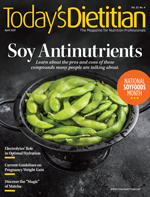 April 2021 Issue
April 2021 Issue
Ask the Expert: Chlorella
By Toby Amidor, MS, RD, CDN, FAND
Today’s Dietitian
Vol. 23, No. 4, P. 10
Q: Some of my clients have been asking about taking chlorella for various health conditions. What is it, and is there research on its effects?
A: Chlorella is a genus of green freshwater single-celled algae comprising more than 10 species with over 100 strains. It recently has gained popularity as “the new spirulina”—referring to the popular supplemental algae—and is commercially produced and distributed as a dietary supplement, usually in the form of a powder, tablet, or liquid extract.
Proponents claim it may prevent and/or treat a multitude of health issues, including cancer, hepatitis C, nonalcoholic fatty liver disease, the common cold, asthma, lead toxicity, aging, premenstrual syndrome, metabolic syndrome, peptic ulcers, and cardiovascular risk factors such as hypertension and hyperlipidemia.
The impact of chlorella supplements hasn’t been studied for many of the aforementioned health issues, but some research does exist. This article focuses on studies surrounding management of CVD risk factors and metabolic syndrome, as well as chlorella’s nutrient composition, since many individuals consume it due to its nutrient density.
Nutrient Composition
Chlorella provides a unique and diverse array of nutrients, including proteins, omega-3 polyunsaturated fatty acids, polysaccharides, vitamins, and minerals.1 The macro- and micronutrients in chlorella extracts and powders have been reported. However, its nutrition content varies—sometimes dramatically—due to different growing, harvesting, and processing conditions and because recommended dosages are inconsistent. Dried preparation of chlorella can comprise 7% to 88% protein, 6% to 38% carbohydrates, and 7% to 75% fat. It includes omega-3 and omega-6 fatty acids as well as fiber.2
Micronutrients in chlorella include vitamin B12 (as methylcobalamin), vitamin B6, vitamin D, folate, vitamin K, iron, zinc, copper, and magnesium. It also contains sporopollenin—a polymer that makes up the tough outer wall of certain plant cells and is purported to have its own benefits for pain, stress, and depression—and numerous antioxidants, such as beta-carotene, ascorbic acid, alpha-tocopherol, and zeaxanthin.2
Science and Safety
A 2020 review looked at a meta-analysis on the effects of a chlorella supplement on cardiovascular risk factors. The data suggest it may improve total and LDL cholesterol levels, systolic and diastolic blood pressure, and fasting blood glucose levels, but not triglyceride or HDL cholesterol levels. The authors of the review postulate that the beneficial effects of chlorella may be due to the synergism between multiple nutrients and antioxidant compounds. However, there’s limited research on the bioactive compounds in chlorella.3
A 2006 study examined the effects of dried chlorella powder on blood pressure, cerebral stroke lesions, and lifespan in rats. Rats 12 weeks in age were fed chlorella (5%, 10%, and 20%) for 13 weeks. Results show that blood pressure significantly decreased in the 10% and 20% groups compared with the untreated control group. In addition, total cholesterol levels were significantly lower in all chlorella groups and average lifespan was longer compared with controls.4
According to a 2016 review article, clinical trials suggest that chlorella supplementation can improve hyperlipidemia and hyperglycemia and—to briefly address research on other conditions—protect against oxidative stress, cancer, and COPD.1
While research is emerging regarding its efficacy, chlorella tends to be well tolerated when taken orally, but some concerns still exist. Reported adverse reactions include gastrointestinal complaints, fatigue, photosensitivity, thrombocytopenia, and allergic reaction. Since chlorella can cause skin to become extra sensitive to the sun, clients taking it should wear sunblock and engage in other sun-protective measures outdoors. In addition, chlorella is contraindicated in those taking warfarin (Coumadin), as chlorella contains large amounts of vitamin K. Its manganese content also can pose a risk; manganese-induced parkinsonism has been reported after long-term ingestion of chlorella.2
Takeaways for RDs
Dietetics practitioners should make clients aware of chlorella’s safety risks and the limits of the research regarding its efficacy for various conditions. However, if clients choose to take chlorella supplements, nutrition professionals should recommend they take an oral supplement only for the short term—no longer than to 29 weeks.2
In addition, due to great variability among products and the fact that supplements’ nutrient content isn’t regulated, unless verified by a third party such as US Pharmacopeia or ConsumerLab.com, RDs can advise clients taking chlorella for its nutrient density to not rely on it too heavily for micronutrient intake.
— Toby Amidor, MS, RD, CDN, FAND, is the founder of Toby Amidor Nutrition (tobyamidornutrition.com) and a Wall Street Journal best-selling author. Her cookbooks include The Best 3-Ingredient Cookbook, The Best Rotisserie Chicken Cookbook, The Create-Your-Plate Diabetes Cookbook, Smart Meal Prep for Beginners, The Easy 5-Ingredient Healthy Cookbook, The Healthy Meal Prep Cookbook, and The Greek Yogurt Kitchen. She’s a nutrition expert for FoodNetwork.com and a contributor to U.S. News Eat + Run and other national outlets.
References
1. Panahi Y, Darvishi B, Jowzi N, Beiraghdar F, Sahebkar A. Chlorella vulgaris: a multifunctional dietary supplement with diverse medicinal properties. Curr Pharm Des. 2016;22(2):164-173.
2. Chlorella. Natural Medicines Database website. https://naturalmedicines.therapeuticresearch.com/databases/food,-herbs-supplements/professional.aspx?productid=907#scientificName
3. Bito T, Okumura E, Fujishima M, Watanabe F. Potential of chlorella as a dietary supplement to promote human health. Nutrients. 2020;12(9):2524.
4. Sansawa H, Takahashi M, Tsuchikura S, Endo H. Effect of chlorella and its fractions on blood pressure, cerebral stroke lesions, and life-span in stroke-prone spontaneously hypertensive rats. J Nutr Sci Vitaminol (Tokyo). 2006;52(6):457-466.
